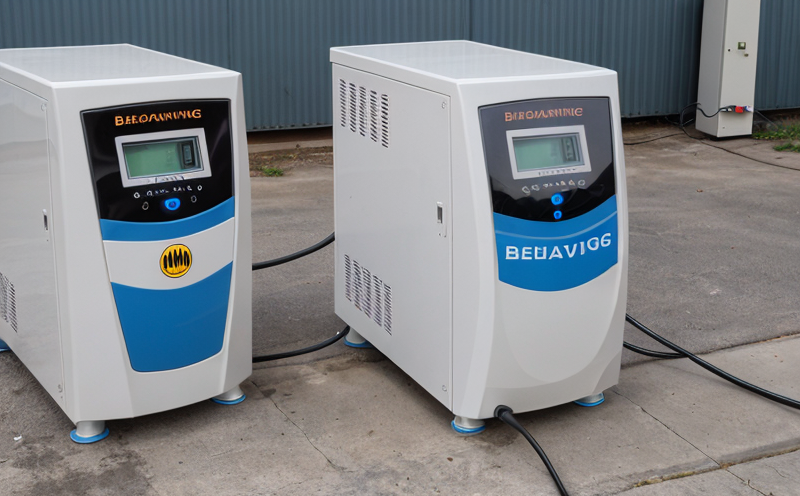IEC 62987 Charging and Discharging Testing of Traction Batteries for Industrial Trucks
The IEC 62987 standard is an essential tool for ensuring the safety, reliability, and performance of traction batteries used in industrial trucks. This testing protocol focuses on evaluating the charging and discharging behavior of these batteries to ensure they meet stringent international standards.
Charging and discharging tests are critical because they assess how efficiently a battery can accept and release energy during its operational life cycle. These tests help identify potential weaknesses in design, manufacturing processes, or material selection that could compromise the battery's performance and longevity. The results of these tests provide valuable insights for manufacturers to improve product quality, enhance safety features, and extend battery lifespan.
According to IEC 62987, traction batteries are subjected to various types of charging and discharging cycles under controlled conditions. This includes deep discharge testing, which simulates real-world scenarios where the battery is fully depleted and then recharged multiple times. Such tests help determine how many cycles a battery can undergo before its capacity drops below an acceptable threshold.
The standard also mandates that batteries be tested for their maximum allowable voltage during charging and minimum allowable voltage during discharging. This ensures that the battery operates within safe limits, preventing overcharging or deep-discharge conditions that could damage the cells.
Additionally, IEC 62987 requires testing for internal resistance of the batteries. High internal resistance can indicate issues such as poor electrical connections or deteriorating cell health, both of which are detrimental to battery performance and lifespan. By monitoring this parameter, manufacturers can quickly identify and address any potential problems early in the production process.
Another key aspect of IEC 62987 is the requirement for temperature control during testing. Batteries perform differently at varying temperatures, so maintaining consistent conditions helps ensure accurate results. This also aligns with real-world usage where industrial trucks operate across a wide range of environmental temperatures.
The standard specifies detailed procedures and apparatus required to conduct these tests accurately. It recommends the use of sophisticated test equipment capable of precise voltage monitoring, current measurement, temperature regulation, and data logging capabilities. Compliance officers responsible for ensuring adherence to IEC 62987 should familiarize themselves with these specifications to guarantee accurate results.
Manufacturers who comply with IEC 62987 not only enhance their products' performance but also demonstrate a commitment to quality and safety, which is crucial in the industrial truck sector. By adhering to this standard, they can mitigate risks associated with battery failure, reduce maintenance costs, and ultimately improve overall operational efficiency.
| Application Scenario | Description |
|---|---|
| Deep Discharge Testing | This involves fully discharging the battery to its minimum allowable voltage and then recharging it back to full capacity multiple times. It simulates realistic operational conditions experienced by industrial trucks. |
| Maximum Voltage During Charging | The test ensures that the battery does not exceed a specified upper limit during charging, which helps prevent overheating and potential damage to the cells. |
| Minimum Voltage During Discharging | This checks that the battery maintains its minimum operational voltage throughout discharging cycles, ensuring safe and efficient performance. |
| Internal Resistance Measurement | The test measures the internal resistance of the battery to identify any issues with electrical connections or cell health. High resistance can indicate poor connections or deteriorating cells. |
Applied Standards
The primary applied standard for this service is IEC 62987, which provides comprehensive guidelines on how to perform charging and discharging tests on traction batteries. This international standard ensures that the testing methods are consistent across different regions and manufacturers.
Compliance with IEC 62987 also aligns with other relevant standards such as ISO/IEC 17025 for laboratory accreditation, which guarantees that the testing facility meets high-quality technical requirements. Additionally, adherence to these standards is crucial for meeting regulatory requirements in various countries.
- IEC 62987: This standard covers the charging and discharging behavior of traction batteries used in industrial trucks, ensuring they meet safety and performance criteria.
- ISO/IEC 17025: Laboratory accreditation to ensure consistent and reliable testing methods.
Industry Applications
The IEC 62987 standard finds significant application in the industrial truck sector, where reliability and safety are paramount. Here are some key areas:
- Manufacturing Quality Control: Ensures that newly produced batteries meet all specified performance criteria before being released into the market.
- R&D Development: Provides a robust framework for developing new battery technologies and improving existing ones by identifying any shortcomings during testing.
- Purchasing Decision-Making: Enables procurement teams to evaluate different suppliers based on their adherence to international standards like IEC 62987.
- Safety Compliance: Guarantees that the industrial trucks powered by these batteries operate safely and efficiently in various environments.
Competitive Advantage and Market Impact
Compliance with IEC 62987 offers several competitive advantages and market impacts:
- Enhanced Safety: Demonstrating adherence to international standards boosts consumer confidence, reducing the risk of accidents or product recalls.
- Improved Product Quality: By rigorously testing batteries according to this standard, manufacturers can ensure superior performance and reliability compared to non-compliant competitors.
- Regulatory Compliance: Ensures that products meet regulatory requirements in multiple countries, opening up broader market opportunities.
- Innovation Leadership: Adhering to the latest standards encourages continuous improvement and innovation within the industry.





